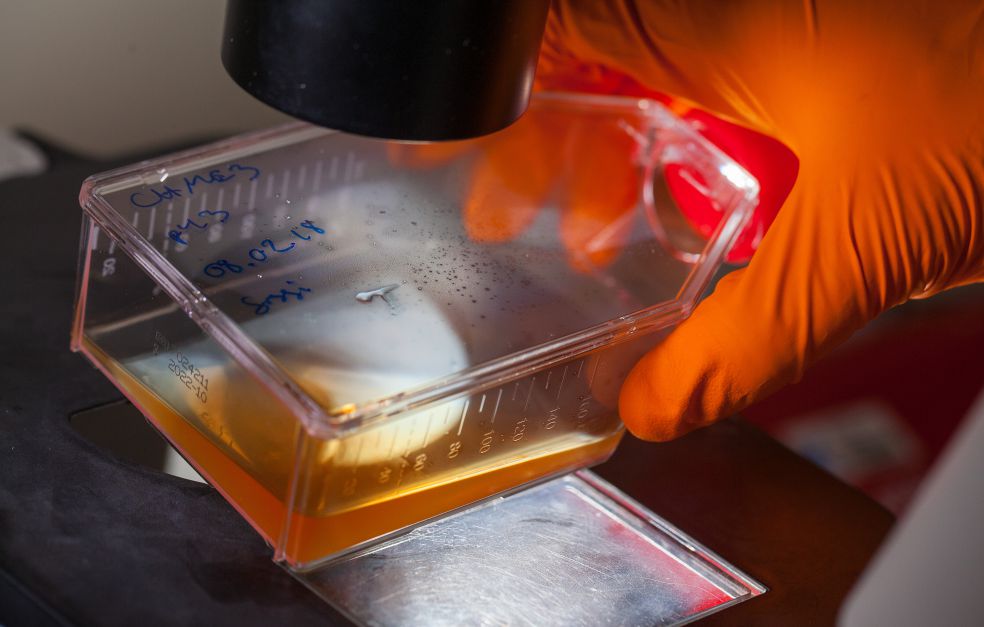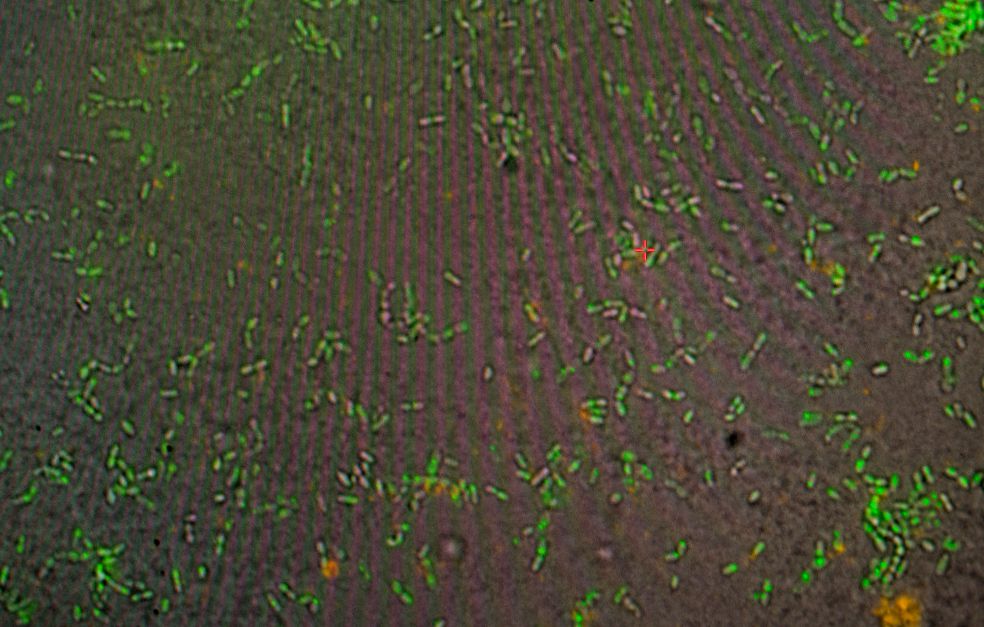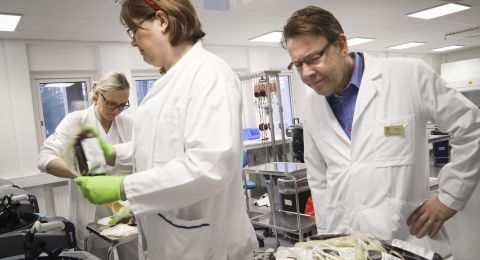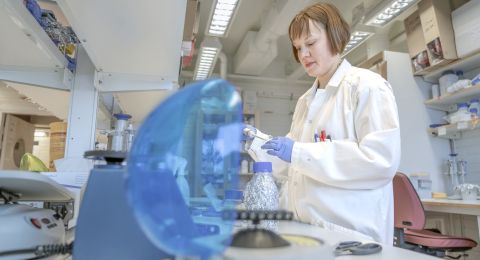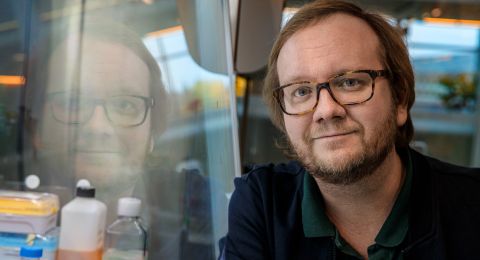Pneumococci are bacteria commonly found in the noses of healthy children. But they can also lead to severe infections, causing the death of about two million people every year. The research of Wallenberg Clinical Scholar Birgitta Henriques Normark focuses on why pneumococci sometimes cause diseases, and aims at gaining knowledge that eventually can contribute to better treatment.
Brigitte Henriques Normark
Senior consultant and Professor of Clinical Microbiology
Wallenberg Clinical Scholar, prolongation grant 2023
Institution:
Karolinska Institutet
Research field:
Pathogenesis and development of resistance in Streptococcus pneumoniae
“Here we can clearly see which bacteria are susceptible to antibiotics,” Henriques Normark says, holding up a culture plate in the laboratory at Karolinska Institutet.
Pneumococci, or Streptococcus pneumoniae, to give them their full name, are growing on the plate. The research of Henriques Normark is focused on this common, but sometimes deadly, bacterium.
Major cause of community-acquired pneumonia
Every year about two million people across the world die from pneumococcal infections. Those most at risk are children under the age of two, and the elderly.
Pneumococci are the most common cause of community-acquired pneumonia, sinusitis and ear infections (otitis). But they can also spread into the bloodstream, causing blood poisoning, and to the brain, where they can cause meningitis. About 1,300 cases of severe pneumococcal infections are reported to the Public Health Agency of Sweden every year.
But even though pneumococci can cause severe infections, they are commonly present in healthy children. Studies at day-care centers have shown that up to 60 percent of attending children may have pneumococci in their nose.
It is not fully understood why the bacteria are usually harmless, yet sometimes cause severe infections. Henriques Normark is trying to find out why.
“Bacteria interact with the host immune system. If we can gain a better understanding of this interaction, we will be able to develop better diagnostics, find better treatments, and better vaccines.”
Non-vaccine type strains are emerging
Vaccines against pneumococci were included in the childhood vaccination program in Sweden in 2009. These vaccines have been developed to protect against certain types of pneumococci that usually lead to severe infections in children. But they only protect against a fraction of the almost hundred different types of pneumococci described to date.
Since the conjugated vaccines were introduced, fewer Swedish children under the age of five have developed severe pneumococcal infections. But the number of these infections across the population as a whole has not fallen, since the adults make up a larger group.
And Henriques Normark points out that pneumococci are still found in the nose of about 30 percent of healthy children. But they now carry a large amount of pneumococcal type strains against which the vaccines offer no protection. These bacterial strains are also found in the adults.
“We will have to deal with completely different kinds of pneumococci. Over 70 percent of the elderly who get a severe pneumococcal infection are infected with pneumococcal types not included in the current conjugated pneumococcal vaccines. So the problem has not been solved yet, and we are monitoring developments.”
The project is using collections of pneumococci isolated from patients with severe infections, along with pneumococci from healthy carriers. The research team characterizes these strains of bacteria in various ways, so they can see which characteristics enable the bacteria to cause disease. They are studying the DNA, as well as the molecules for which the genes code (such as proteins), and how they are affected by the environment.
“The bacteria might not display the same characteristics in the nose, where the temperature is about 32 degrees Celsius, as in the blood, where it is 37 degrees. This is an example of how the surroundings may impact the way bacteria can spread in the body and cause disease.”
Stopping bacteria from causing disease
Pneumococci appear as green balls on the microscope monitor in the lab at Karolinska Institutet. Henriques Normark’s team were the first to discover that certain pneumococci have hair-like appendages on their surface, known as pili.
They found that specific proteins in pili affect the ability of bacteria to bind to cells in the lungs, and cause pneumonia, as well as their ability to pass through the blood-brain barrier, causing meningitis.
The research team has also identified target proteins in the host, on the cells in the blood-brain barrier, that detect bacterial pilus proteins.
”This grant is essential for us in order to continue to study how pneumococci cause disease, and try to develop new ways of preventing and treating infections. This substantial long-term funding will enable us to address issues that are more demanding and more time-consuming. The ability to plan in the long term is incredibly important and beneficial for research.”
This knowledge offers potential for preventing bacteria from infecting the brain by blocking the target proteins. Using an animal model, the team has demonstrated that there were substantially fewer bacteria in the brains of animals given antibodies to block target proteins than in untreated animals.
Pneumococcal infections can normally be treated with antibiotics. But a growing proportion of pneumococci are resistant to antibiotics, reducing the scope for effective treatment.
Henriques Normark is studying how pneumococci become resistant to antibiotics. One of her observations is that resistant bacteria often have pili.
“It may be one reason why they frequently colonize humans and spread from one person to another. We will continue to study whether we can prevent the spread of resistant strains of bacteria, perhaps by targeting pili.”
The research team’s work covers the whole chain – from molecule to patient. Henriques Normark believes her background as a physician has greatly influenced the focus of her research.
“My work centers on the patient – what can we to do to help the patient to recover, to make the right diagnosis, and prevent disease? This is what makes our research relevant,” she explains.
Text Sara Nilsson
Translation Maxwell Arding
Photo Magnus Bergström

